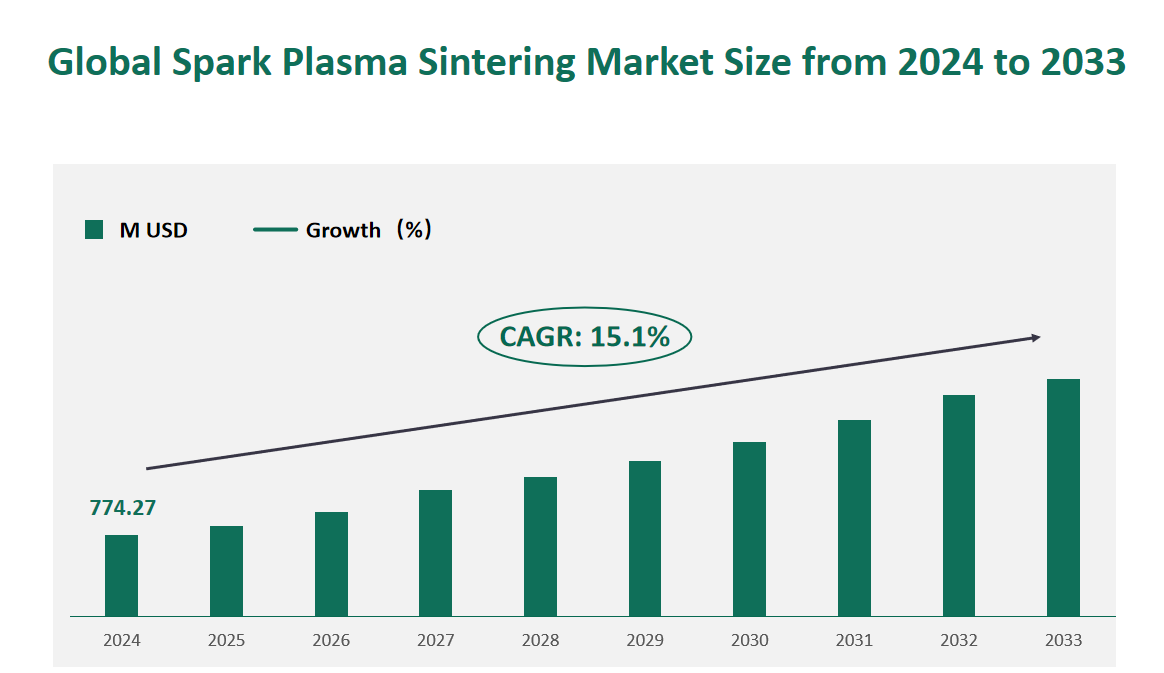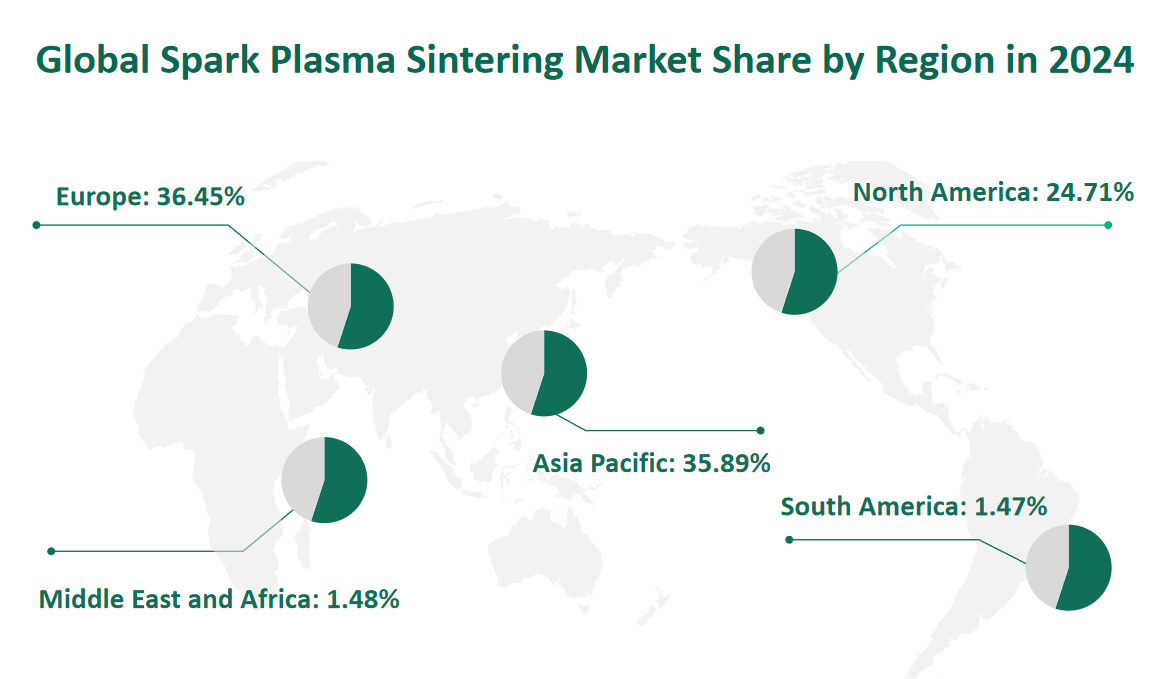1 Global Spark Plasma Sintering Market Size (Value) and CAGR (2024-2033)
In 2024, the global Spark Plasma Sintering market was valued at USD 774.27 million, with a CAGR of 15.1% from 2024 to 2033.
Spark Plasma Sintering is a cutting-edge technology that compresses and sinters materials to achieve higher densities. It involves placing material powder into a mold and applying specific sintering power and pressure using upper and lower die punches and electrified electrodes. The process is activated by electric discharge, resulting in the production of high-performance materials. This technology is particularly valuable in industries such as aerospace, automotive, energy, healthcare, and defense, where materials with superior properties are required.
Figure Global Spark Plasma Sintering Market Size (M USD) and CAGR 2024-2033

2 Spark Plasma Sintering Market Growth Drivers
Demand for High-Performance Materials: Industries such as aerospace, automotive, and electronics require materials that can withstand extreme conditions and provide enhanced performance. SPS technology is uniquely capable of producing dense and fine-grained materials with superior mechanical properties, making it highly valued in these sectors.
Versatility in Material Processing: SPS can process a wide variety of materials, including metals, ceramics, and composites. This versatility has broadened its appeal and led to increased investment in research and development to explore new applications.
Technological Advancements: Continuous advancements in sintering technology have improved the efficiency and effectiveness of the SPS process. Manufacturers are finding new ways to enhance material performance while reducing production costs, further driving market growth.
Increasing Research and Development: Companies are heavily investing in R&D to develop new materials and components using SPS technology. This investment is not only driving innovation but also expanding the market’s product offerings.
3 Spark Plasma Sintering Market Challenges
Technical Challenges:
In materials like transparent ceramics, controlling grain growth is crucial for maintaining mechanical and optical properties. Conventional sintering methods often lead to excessive grain growth, reducing material performance. SPS offers a solution by allowing finer grain structures, but achieving consistent results can be challenging.
The SPS process requires precise control of parameters such as temperature, pressure, and heating rate. Optimizing these parameters for different materials and applications is a complex task that requires extensive research and development.
Market Entry Barriers:
The high cost of SPS equipment and the need for specialized facilities can deter new entrants. This barrier is particularly significant for small and medium-sized enterprises (SMEs) that may lack the financial resources to invest in such technology.
Operating SPS equipment requires skilled personnel with specialized training. The shortage of trained professionals can limit the adoption of SPS technology, especially in emerging markets.
4 Global Spark Plasma Sintering Market Size and Share by Type in 2024
Metal SPS is a dominant segment, expected to generate a revenue of 136.71 million USD in 2024. This type is favored in industries such as aerospace and automotive due to its ability to produce components with high strength and durability. The metal SPS process allows for the rapid sintering of metal powders into dense, high-performance parts, which is crucial for applications requiring resistance to extreme mechanical and thermal stresses.
Ceramic SPS is another significant type, with a projected revenue of 112.86 million USD in 2024. Ceramics are known for their hardness, wear resistance, and thermal stability, making them ideal for applications in electronics, cutting tools, and high-temperature environments. The SPS process enables the production of ceramic components with controlled microstructures and improved mechanical properties, which are essential for advanced technological applications.
Biomaterial SPS is a growing segment, expected to reach a revenue of 33.36 million USD in 2024. This type is crucial in the medical and dental fields, where biocompatibility and specific mechanical properties are required. Biomaterial SPS allows for the fabrication of implants and medical devices with tailored properties, enhancing patient outcomes and the performance of medical treatments.
Table Global Spark Plasma Sintering Market Size and Share by Type in 2024
Type | Market Size (M USD) 2024 | Market Share 2024 |
Metal | 136.71 | 34.02% |
Ceramic | 112.86 | 28.09% |
Biomaterial | 33.36 | 8.30% |
Others | 118.92 | 29.59% |
5 Global Spark Plasma Sintering Market Size and Share by Application in 2024
Aerospace is a key application area for SPS, with a projected revenue of 56.8 million USD in 2024. This sector requires materials that can withstand extreme conditions such as high temperatures, pressures, and corrosive environments. SPS is used to produce components with improved mechanical properties, lighter weight, and better corrosion resistance, making it an essential technology in aerospace.
Automotive is another significant application, expected to generate a revenue of 45.01 million USD in 2024. The automotive industry is increasingly demanding high-performance materials for components such as brake pads and clutch plates. SPS technology allows for the production of these components with higher strength and durability, contributing to the industry’s need for lightweight and efficient materials.
Energy is a growing application area, with a projected revenue of 34.64 million USD in 2024. The energy sector, including renewable and non-renewable sources, requires materials that can operate efficiently and withstand harsh conditions. SPS is used to produce components with improved mechanical properties, lighter weight, and better corrosion resistance, which are crucial for the development of advanced energy systems.
Healthcare is an emerging application, expected to reach a revenue of 28.36 million USD in 2024. In the healthcare industry, SPS is used to produce high-performance materials for medical devices and implants. These materials need to meet strict standards for biocompatibility and mechanical performance, making SPS an ideal choice for this sector.
Mechanical/Metallurgical applications are also significant, with a projected revenue of 75.44 million USD in 2024. The mechanical and metallurgical industries require materials with high hardness and specific mechanical properties. SPS is used to produce dense and high-performance materials that meet these requirements, contributing to the efficiency and durability of tools and components.
Defense is a major consumer of SPS technology, with a projected revenue of 99.73 million USD in 2024. The defense industry requires ultra-high-performance components with strict requirements such as lightness and strength. SPS provides the defense sector with components that have improved mechanical properties and enhanced performance, contributing to the sector’s need for advanced materials.
Table Global Spark Plasma Sintering Market Size and Share by Application in 2024
Application | Market Size (M USD) 2024 | Market Share 2024 |
Aerospace | 56.80 | 14.13% |
Automotive | 45.01 | 11.20% |
Energy | 34.64 | 8.62% |
Healthcare | 28.36 | 7.06% |
Mechanical/Metallurgical | 75.44 | 18.77% |
Defense | 99.73 | 24.82% |
Others | 61.87 | 15.40% |
6 Global Spark Plasma Sintering Market Size and Share by Region in 2024
North America is a significant market for SPS, with a projected revenue of 191.34 million USD in 2024. This region is characterized by a strong presence of advanced research institutions and industries such as aerospace and automotive. The United States, in particular, is a leader in SPS technology, with companies and research institutions continuously investing in the development of high-performance materials.
Europe is a leading market for SPS, with a projected revenue of 282.21 million USD in 2024. Europe’s strong industrial base, particularly in countries like Germany, France, and the UK, drives the demand for SPS technology. The region’s commitment to sustainable and high-performance materials is evident in its applications in aerospace, automotive, and energy sectors.
Asia-Pacific is a rapidly growing market for SPS, with a projected revenue of 277.85 million USD in 2024. The region’s economic dynamism and industrial expansion, particularly in countries like China, Japan, and South Korea, contribute to the high demand for SPS technology. The focus on electronics, automotive, and renewable energy drives the need for advanced materials.
Figure Global Spark Plasma Sintering Market Share by Region in 2024

7 Major Players in Global Spark Plasma Sintering Market
7.1 Dr. Fritsch
Dr. Fritsch is a leading company in the SPS market, known for its innovative and high-quality products. Established in 1953, Dr. Fritsch is a technology and market leader in FAST/SPS machines for industrial applications, as well as for research and development.
The company provides a comprehensive range of FAST/SPS machines and powder handling equipment, including mixing, granulating, and cold pressing. Dr. Fritsch also offers first-class brazing, welding, and grinding machines, as well as raw materials such as metal powder and diamonds, catering to the diamond tool industry.
In the most recent year, Dr. Fritsch reported a revenue of 35.26 million USD with a gross margin of 37.37%.
7.2 FCT Systeme
FCT Systeme is another major player in the SPS market, recognized for its customized high-temperature equipment and advanced sintering technologies. Founded in 1983, FCT Systeme GmbH manufactures industrial machinery and equipment, specializing in the development and production of hot pressing, air pressure, and vacuum maximum temperature sintering and spark plasma sintering equipment.
The company is particularly known for its densification of powdered metals and non-oxide engineering ceramics. FCT Systeme’s Spark Plasma Sintering system is a new sintering technique that uses DC current pulses to directly heat the tool and component, reducing cycle times to a few minutes. This technology offers significant advantages in terms of energy efficiency and material performance.
In the most recent year, FCT Systeme reported a revenue of 32.95 million USD with a gross margin of 38.60%.
7.3 Fuji Electronic
Fuji Electronic Industrial is a Japanese electrical equipment company that has made significant strides in the SPS market. Established in 1954, the company manufactures a wide range of products including pressure transmitters, flow meters, gas analyzers, controllers, inverters, pumps, generators, ICs, motors, and power equipment.
Fuji Electronic Industrial’s Spark Plasma Sintering technology is a newly developed synthesis process that employs ON-OFF pulse DC voltage/current, which has received considerable attention in the field of advanced new material development. The company has over 30 years of experience in the field of SPS and provides not only SPS hardware but also consistent service for powder metallurgy and sintering technology.
In the most recent year, Fuji Electronic Industrial reported a revenue of 32.24 million USD with a gross margin of 40.62%.

